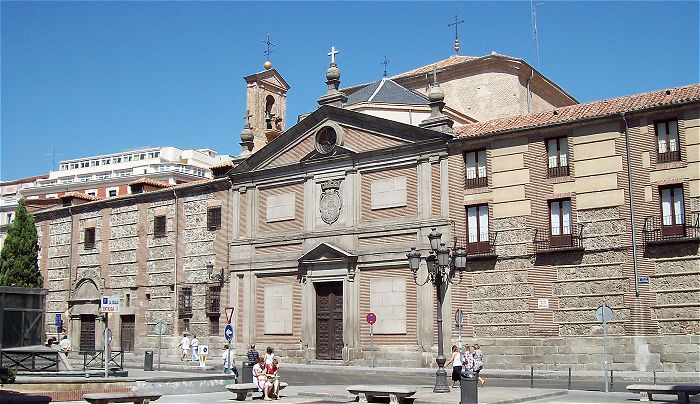Convent of Las Descalzas Reales
See photo below
by Joan Saunders. May 2007
The Convent of Las Decalzas Reales in Madrid (Convent of the Royal Barefoot Nuns), Spain
is not a traditional museum. It is a functioning convent for cloistered nuns that displays
its works of art as an expression of the life of the religious community and
of the royal patronage it has received since its founding nearly 400 years ago by a member
of the Spanish Royal Family.
The royal connection with the convent (then a private home) began there in 1535 with the
birth of a daughter to Emperor Charles V and his wife, Isabella of Portugal. A generation
earlier the Austrians and Spanish were joined politically when Charles’ mother
Joan, daughter of the Spanish monarchs Isabella and Ferdinand, married Philip I, son of
Emperor Maximilian I of Austria. When their son Charles V and his wife were expecting
their fourth child, Charles advised her to leave her apartment in the old palace-fortress
in Madrid for a more comfortable accommodation in the Renaissance palace of his bookkeeper
and good friend, Don Alonso Gutierrez. There on 23 June 1535, Joan of Austria was born in
what her brother King Philip II was later to call “the cool rooms that overlook
the garden.”
Twenty years later, when Philip II left for England to marry Mary Tudor, he asked his
sister Joan to act as Regent of Castile and Aragon in his absence. Wishing to established
a convent as a place of withdrawal and prayer, Joan purchased Gutierrez’s
palace as home for the convent she founded, the Convent of Las Descalzas Reales. Her plan
was to create a religious and social complex which included a convent, a church for the
people, apartments for the monarchs and a residence for other members of the royal family.
The order of nuns who have occupied this convent since its inception are the cloistered
Franciscan nuns, the Poor Clares, established in the early 13th century by St Francis and
St Clare near Assisi, Italy. Joan wanted to be buried in the palace where she was born and
the convent she established, so in 1573, per her wish, she was entombed in the church of
the Convent Las Descalzas Reales.
The convent houses an extensive art collection, much of it donated by members of the Royal
Family for their and the nuns’ spiritual edification. In addition there are 39
portraits of the Royal Family, including Joan of Austria, and several Royals familiar to
Ringling Docents: Isabella Clara Eugenia, Philip IV, his brother Ferdinand, his wife Dona
Maria Anna, and their three children Margarita Theresa, Philipe Prospero, and Charles II.
Artists represented in the convent’s collection include Bruegel, Cano,
Correggio, Dolci, Giordano, Luini, Piombo, Pontormo, Ribera, Rubens, Titian, and Zurbaran.
Of major interest to Ringling Docents are the Victory of
the Eucharist tapestries, designed by Peter Paul Rubens and woven in Brussels by
Jan Raes, Jacques Fobert, and Jacques Geubels. These were given to the convent by Isabella
Clara Eugenia, Governor of the Spanish Netherlands, in thanksgiving for the Spanish
victory at Breda in 1625.
Since 1970 ten of the tapestries have been installed in the largest space in the convent,
a T-shaped room that was formally the nuns’ dormitory, and new cells were
created for the nuns. The remaining ten tapestries are stored in an enclosed area;
however, some of these are displayed to the public in the chaplain’s cloister on
Good Friday. Four of the ten tapestries on display are from cartoons in the Ringling
Museum: The Defenders of the Faith, The Four
Evangelists, Manna in the Desert, and The Meeting
of Abraham and Melchizedek. The other six are Allegory
of Franciscan Asceticism, Charity Illuminated by Dogma, The Prophet Elijah Comforted by an
Angel, The Triumph of the Eucharist over Idolatry, The Triumph of the Eucharist over
Ignorance and Blindness, and Wisdom Inspired by the Holy Spirit. A portrait of
Isabella Clara Eugenia, painted according to
Ruben’s model, hangs between two tapestries. She belonged to the Third
Franciscan Order for secular vocations, and is dressed as a Franciscan Tertiary.
In 1960, with the permission of the nuns, the Patrimonia
Nacional, the institution entrusted with administering royal patronage, opened
certain areas of the convent to the public as a museum. Since then more areas were opened,
and in 1988 The Convent of Las Decalzas Reales was awarded the Council of Europe
‘s Museum Prize. However, the convent is not a traditional museum. It is a
working convent with a world class collection of art.
Principal source: Ana Garcia Sanz and M Leticia Sanchez Hernandez, The Convents of Las Descalzas Reales and La Encarnacion (Two
Cloistered Convents in Madrid). Madrid, Spain: Patrimonio Nacional. 1999
